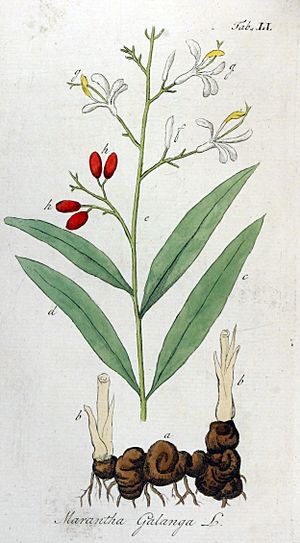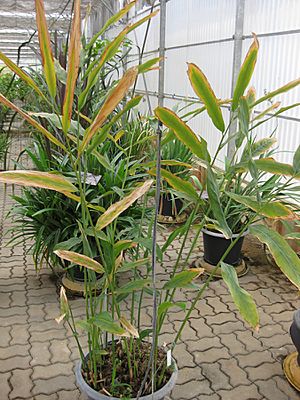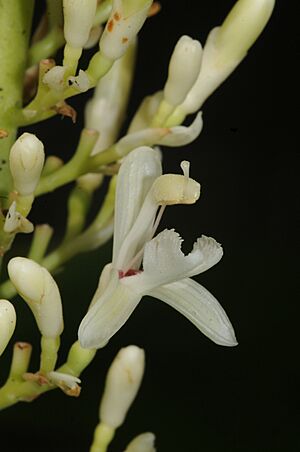Alpinia galanga facts for kids
Quick facts for kids Alpinia galanga |
|
|---|---|
 |
|
 |
|
| Scientific classification | |
| Genus: |
Alpinia
|
| Species: |
galanga
|
Alpinia galanga, often called greater galangal or blue ginger, is a plant from the ginger family. It has a special underground stem called a rhizome. This rhizome is used as a spice in cooking, especially in Arab cuisine and Southeast Asian food. It's also used as an herb in traditional medicine.
Alpinia galanga is one of four plants known as "galangal". You might hear it called lengkuas in some places.
Contents
What's in a Name?
The word "galangal" likely comes from the Persian word qulanjan or Arabic khalanjan. These words might have come from the Chinese name gao liang jiang. In North India, similar names like kulanja (in Sanskrit) and kulanjan (in Hindi) are used.
The name "lengkuas" comes from the Malay word lengkuas. Many other languages in the Western Malayo-Polynesian family have similar names. For example, in Tagalog, it's called langkáuas. Sometimes, these names are also used for other similar plants.
Alpinia galanga has many other names around the world. In Javanese, it's laos, and in Sundanese, it's laja. People in Cambodia call it romdeng, and in Thailand, it's kha. In Japan, it's nankyo, and in Mandarin Chinese, it's hong dou kou. In Tamil, it's known as "Pae-reeya-ra-thai". In Sri Lanka, it's called Araththa.
Where Does Galangal Come From?
Lengkuas first grew in Southeast Asia. It was first grown a lot in Java during the spice trade. Today, it's still grown widely in places like the Greater Sunda Islands and the Philippines. It has also spread to Mainland Southeast Asia, especially Thailand.
The leaves of lengkuas are used by the Kavalan people in Taiwan. They roll the leaves to make a traditional children's toy called nanel. This toy is common among many Austronesian cultures.
What Does the Plant Look Like?
This plant grows from its underground stems, called rhizomes. It forms clumps of tall, stiff stalks that can reach up to 2 meters (about 6.5 feet) high. It has many long leaves and produces red fruits.
The rhizome is the part of the plant most often used in cooking. It has a strong smell and a taste that reminds people of citrus fruits, black pepper, and even pine needles. There are red and white types of galangal. Red types are often used for medicine, while white types are mostly used as a spice in food. The small red fruit is also used in traditional Chinese medicine. It tastes a bit like cardamom.
How Is Galangal Used in Cooking?
The galangal rhizome is a common ingredient in many Thai curries and soups. A famous example is tom kha kai, a creamy chicken soup. In these dishes, galangal is used fresh, either in chunks or sliced thinly. It can also be mashed and mixed into curry paste.
In Indonesian cooking, especially in dishes like rendang, galangal is a key spice. It adds a special flavor to the rich meat stew.
The Mansaka people in the Philippines traditionally ferment galangal with honey. This mixture is used to make a wine called byais.
Galangal in Traditional Medicine
In some African American folk medicine and hoodoo practices, galangal is known by names like 'chewing John' or 'court case root'.
In Unani medicine, A. galanga is called 'Khulanjan'. Old Unani books, like The Canon of Medicine, mention its uses. It's believed to be good for the heart, to make you feel happy, and to help with breathing problems. It's used for conditions like Asthma, coughs, and sore throats. Some famous Unani medicines, like Habb e Jadwar, use Khulanjan as an ingredient.
In Ayurveda, another traditional medicine system, A. galanga (called rasna in Sanskrit) is used to help balance the body. In Tamil medicine, it's known as perarathai. It's often used with licorice root (called athi-mathuram) as a folk remedy for colds and sore throats.
See also
 In Spanish: Galanga mayor o galanga verdadera de la India para niños
In Spanish: Galanga mayor o galanga verdadera de la India para niños




